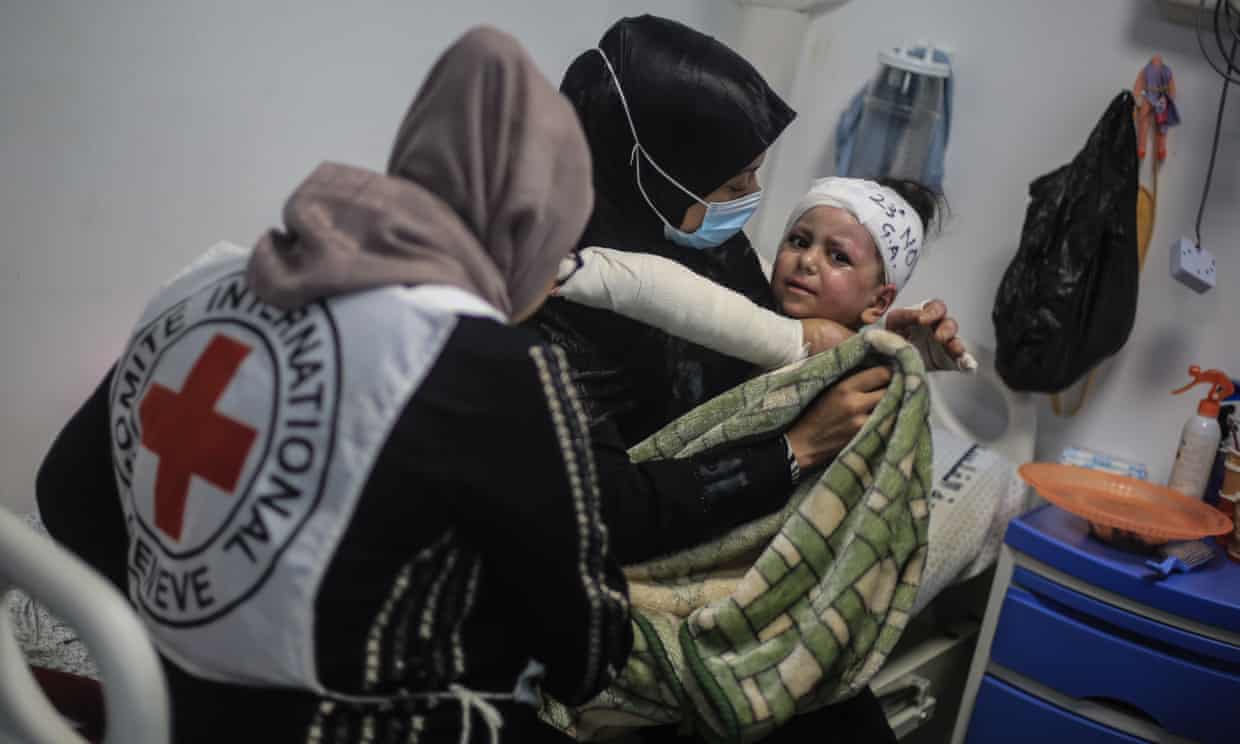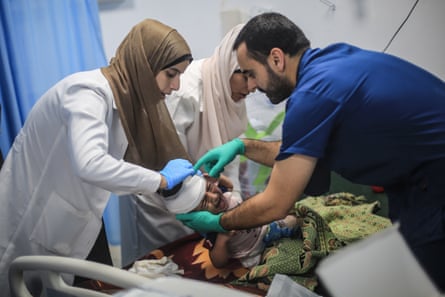A surgeon at one of the territory’s last functioning hospitals tells of desperate conditions amid an acute lack of medicine
 A member of the Red Cross attempts to attend to an injured small child at the European hospital in Khan Younis on Tuesday. Photograph: Mohammed Talatene/Avalon
A member of the Red Cross attempts to attend to an injured small child at the European hospital in Khan Younis on Tuesday. Photograph: Mohammed Talatene/Avalon
Jason Burke, The Guardian, 24 Nov 2023
In the crowded corridors of the European hospital in Khan Younis, exhausted doctors decide who among the huge influx of patients arriving from the north of Gaza should live or die.
Hundreds of casualties have moved south in recent days after the evacuation of hospitals in Gaza City, overwhelming medical staff already struggling with an acute lack of medicine, diminishing food rations and intermittent power and communications.
Injured people have joined thousands of displaced people seeking shelter and safety in medical facilities.
Paul Ley, an orthopaedic surgeon at the European hospital, said displaced people were sleeping in lifts, a small team was working round the clock in four operating theatres to amputate limbs infected after days without treatment, and there was an acute shortage of painkillers. Triage decisions had to be made instantly which, in one case, meant leaving a 12-year-old child to die with only palliative care in order to preserve dwindling resources.
Ley said the hospital had received 500 patients evacuated from hospitals in northern Gaza in recent days.
More

“Many have not received treatment for nine or 10 days because hospitals there were non-functional even if they were open,” he said. “This is the situation that is happening here now. This is a functioning hospital but we are being overwhelmed. There is nowhere to evacuate to … There is no escape route. We are probably one of the last lines of defence.”
There was no independent confirmation of Ley’s account, but details match the accounts of other medical staff, as well as reporters in Gaza. Ley sent pictures of some of the injuries he described to the Guardian.
Israel launched its offensive on Gaza after Hamas, the extremist Islamist group which runs the territory, killed more than 1,200 people in southern Israel, mostly civilians in their homes or at a dance party, in an attack on 7 October.
Since then, more than 14,000 people have been killed in Gaza, most of them women or children, according to Palestinian officials.

In the burns unit of the European hospital are 78 patients, nearly two-fifths of them children under five.
“I have never seen anything like it,” said Ley a 60-year-old French citizen who arrived in Gaza with a team from the International Committee of the Red Cross almost four weeks ago. “I have been in many war contexts where the type of wounds are the same but the number is huge. We never leave the hospital. We work round the clock.”
Hospital staff hope the four- or five-day ceasefire between Israel and Hamas, due to begin on Friday, may lead to a durable end to hostilities – or at least the opportunity to receive supplies of humanitarian aid. However, they also fear the arrival of more patients as injured casualties are evacuated from northern Gaza during any pause.
Many of the casualties arriving at the hospital were injured days before, meaning wounds have become infected. Ley said some people’s dressings had not been changed for 10 days, so their wounds were full of worms. In other cases, surgeons were forced to amputate limbs that may otherwise have been saved.
Another problem is a lack of anaesthetics and painkillers.
“We do operations with minimal anaesthesia. If we run out, we can’t operate but there is no clear line. There are a lot of people crying, screaming with pain, but we don’t have enough analgesics. We keep them for the kids or very severe cases. [So] normally we would change dressings on patients with 40% burns with them under sedation and minimise the time by using more attendants … [Now] it has to be done with a lot of pain.”

In the grounds of the hospital compound, thousands of desperate families are packed into wooden or cardboard shelters. Israeli airstrikes have not targeted the hospital and respected the zone around the facility – though shrapnel has struck the building, and the blast from bombing has shattered windows.
Israeli military officials say they make every effort to avoid civilian casualties and observe international law. They say Hamas is using Gaza’s 2.3 million inhabitants as a human shield and claim to have found evidence of Hamas military facilities in or under hospitals, schools and homes.
On Thursday, the Israeli prime minister, Benjamin Netanyahu, said: “The whole laws of war, humanitarian law, which we’re committed to completely, makes a simple distinction … They say on one line are combatants, and the other line are non-combatants. You can target the combatants … but don’t deliberately target the non-combatants. They can be hurt, unintentionally. That accompanies every legitimate war.
“[Hamas] deliberately implant themselves in hospitals, in schools, in residential areas, in UN facilities. They fire their rockets from there. Thousands of them. They deliberately target civilians and they deliberately hide behind civilians and use them as a human shield. That’s a war crime.”

Elsewhere in Khan Younis, tens of thousands of people have crowded into shelters run by the UN. In one, a vocational training centre before the war, more than 35,000 people share 48 toilets and four showers, administrators there told the Guardian this week.
“Conditions are appalling. All the children are getting sick with coughs or stomach problems. There are fights over sleeping spaces and food,” said an administrator, who did not have authority to talk to the media.
Since the Hamas attacks on 7 October, Israel has imposed an almost total blockade of Gaza. Food supplies from the UN have dwindled to about a kg of flour and a single tin of tuna or beans each day, one administrator said, leaving families to survive on flat “bread cakes” made of flour and water cooked on scavenged metal sheets over open fires.
“There is no food in the shops and no fuel. Even wood is rare and expensive, so people are chopping down trees in the streets. Salt is really rare. No one has any and if you have a bit, you can trade it for a lot of food,” the administrator said.

Ley said the hardest thing for doctors was to make triage decisions. “We do our triage … [asking] are we going to take this patient because they will have a good chance of surviving rather than doing desperate measures on a patient who will die in two or three days? That sounds nice on paper, but when you have to make the decision it is different. There’s a 12-year-old with 90% burns so we won’t treat him except for pain control that is not enough,” he said.
“We try to keep our heads cool and steady, but for local staff this is their families, friends, their people. They never want to amputate. They say: ‘I can’t do it any more’ and so I say: ‘OK I will do it, don’t worry,’ and you can feel the relief”.
Ley said he had been shocked at how passive many patients were, such as one 35-year-old woman whose husband and children had been killed when the family’s home was destroyed, and who appeared unmoved when told both her legs would need to be amputated. “So many just don’t care any more,” he said.
But amid the devastation, there were moments of slender hope. Recently, Ley treated a 32-year-old man with shrapnel injuries to his abdomen, left leg and a “fist-sized hole” in his right forearm. The patient’s young sister thanked Ley, saying she was proud of her brother and happy he was alive. She wanted to be a surgeon whens she was older, she said.
“So that was very poignant,” Ley said.
Leave a Reply